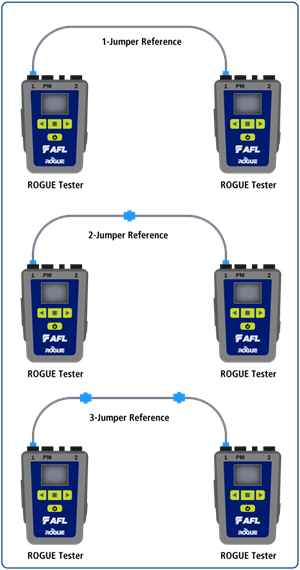BLOG
5 Best Practices for Certifying Next Generation Networks: A Suitable Test Reference Method
09/03/2017
Type and quality of test reference cords
Before we dive into test reference methods, we need to discuss the type and quality of test reference cords. To assure the most accurate loss measurements when testing a link, the use of Reference Grade cables during the referencing process is critical to ensure accuracy, repeatability and reproducibility.
Using average or even poor quality reference cables will lead to understated loss values and in some cases, even negative values (i.e. “gainers”). While negative test values don’t indicate a failure, they can be an indication of an invalid reference so any measurements may become suspect.
High quality Fiber Certification Test Kits will include Reference Grade test jumpers which have been produced with tighter tolerances and improved durability. However, even Reference Grade cables need to be cleaned and inspected prior to referencing every time.
Test reference method: which should I choose?
TIA-526, referred to in TIA-568, specifies three different referencing procedures: 1-jumper reference, 2-jumper reference and 3-jumper reference. These were formerly known as Method B, Method A and Method C, respectively. The naming convention was altered in an attempt to make it easier for users to recognize how many jumpers should be used in the referencing process when testing. The 1-jumper method is the preferred method in the TIA-568 standard, while the ISO-14763-3 standard does not state a preference.
Depending on the application and network being tested, each jumper method has pros and cons and a quality Fiber Certification Kit will allow the user to perform accurate measurements regardless of which method is specified.

For shorter distance applications such as those found within Enterprise networks and Data Centers, the 1-jumper reference procedure is the most commonly used method in the industry today. The 1-jumper method includes the loss of the connections at both ends of the fiber link under test. Because much of the loss on a short fiber link is the result of those connections, this is considered the preferred measurement technique.
2-jumper reference
For Telco or long distance applications where fiber loss dominates the overall loss of the link under test, the simpler 2-jumper method is generally preferred and commonly used. This method is also used when the link under test has connectors that are not compatible with the test equipment.
3-jumper reference
The 3-jumper method is used when the fiber type of the test cords do not match the fiber type in the link. This situation could occur when testing multimode networks where various types of cable are used.
With the increased deployment of MPO-style connectors, a 3-jumper reference procedure is often used to test MPO-to-MPO trunks to account for changes in gender/pinning as well as polarity type (A, B, C).
Conclusion: Employ a suitable test reference method for the application and use reference grade (i.e. high quality) test reference cords. Measurements are only as good as the weakest link.
Have any questions? Feel free to contact us or leave comments below.
Five Best Practices for Certifying Next Generation Networks
- 5 Best Practices for Certifying Next Generation Networks
- 5 Best Practices for Certifying Next Generation Networks: Cleaning and Inspection
- 5 Best Practices for Certifying Next Generation Networks: Encircled Flux
- 5 Best Practices for Certifying Next Generation Networks: Bi-Directional Measurements
- 5 Best Practices for Certifying Next Generation Networks: A Suitable Test Reference Method